Hotpoint-ariston ARTXL 89 User Manual [ru]

Instructions for use
|
|
|
|
|
|
|
WASHING |
|
MACHINE |
|||
|
|
|
|
|
|
|
|
|||||
|
|
|
|
|
|
|
|
|
|
|
||
|
|
|
|
|
|
|
|
|
|
|
|
|
|
|
|
|
|
|
|
Contents |
|
||||
|
|
|
|
|
|
|
GB |
|||||
|
|
|
|
|
|
|
|
|
|
|
||
|
|
|
|
|
|
|
Installation, 2-3 |
|
||||
GB |
|
FR |
|
|
CIS |
|
|
|||||
|
|
|
|
Unpacking and levelling |
||||||||
|
|
|
|
|
|
|
Connecting the electricity and water supplies |
|||||
English,1 |
Français,13 |
РУССКИЙ, 25 |
||||||||||
The first wash cycle |
||||||||||||
|
|
|
|
|
|
|
Technical data |
|||||
|
|
|
|
|
|
|
Description of the washing machine |
|||||
|
|
|
|
|
|
|
||||||
GR |
|
|
|
|
|
|
and starting a wash cycle, 4-5 |
|||||
|
|
|
|
|
|
|
Control panel |
|||||
ЕллзнйкЬ,37 |
|
|
|
|
|
|||||||
|
|
|
|
|
Indicator lights |
|||||||
|
|
|
|
|
|
|
How to open and shut the drum |
|||||
|
|
|
|
|
|
|
Starting a wash cycle |
|||||
ARTXL 89
Wash cycles, 6
Table of wash cycles
Personalisation, 7
Setting the temperature Setting the spin speed Functions
Detergents and laundry, 8
Detergent dispenser drawer Bleach cycle
Preparing the laundry Garments requiring special care Load balancing system
Precautions and tips, 9
General safety Disposal
Saving energy and respecting the environment
Care and maintenance, 10
Cutting off the water or electricity supply Cleaning the washing machine
Caring for your appliance door and drum Cleaning the pump
Checking the water inlet hose
How to clean the detergent dispenser
Troubleshooting, 11
Service, 12
1
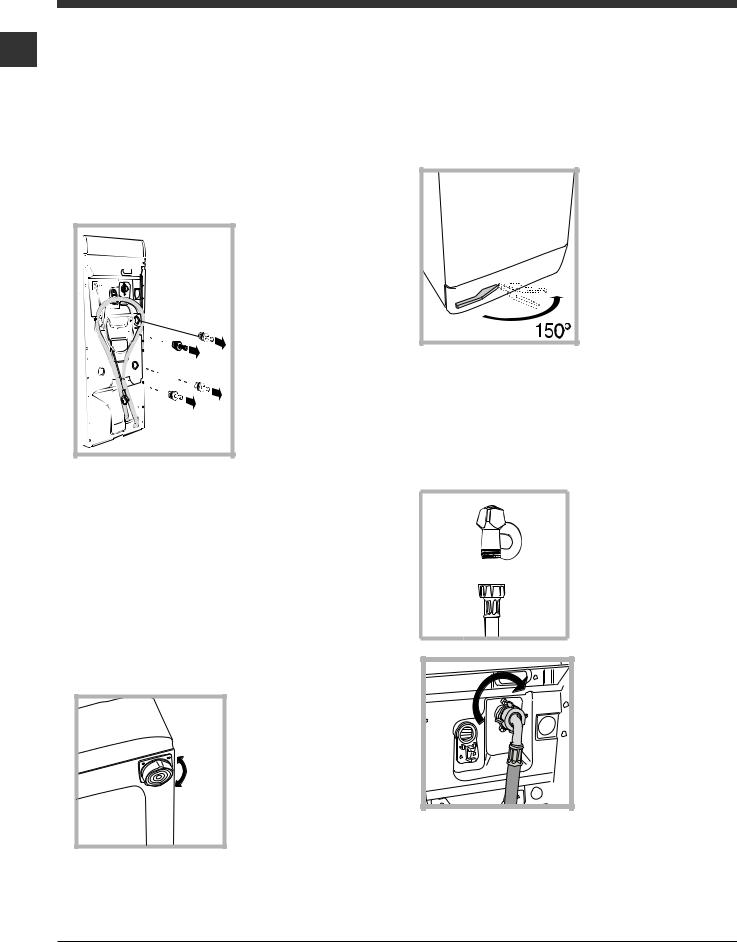
Installation
Keep this instruction manual in a safe place for GB future reference. Should the appliance be sold,
transferred or moved, make sure the instruction manual accompanies the washing machine to inform the new owner as to its operation and features.
Read these instructions carefully: they contain vital information on installation, use and safety.
Unpacking and levelling
Unpacking
1. Unpack the
washing machine.
2. Check whether the
washing machine has
been damaged during
transport. If this is the
case, do not install it
and contact your
retailer.
3. Remove the four protective screws and the rubber washer with the respective spacer, situated on the rear of the appliance (see figure).
4.Seal the gaps using the plastic plugs provided.
5.Keep all the parts: you will need them again if the washing machine needs to be moved to another location.
Warning: should the screws be re-used, make sure you fasten the shorter ones at the top.
Packaging materials are not children's toys.
Levelling
Your machine may make a considerable amount of noise if the two front feet have not been adjusted correctly.
1. Install the washing machine on a flat sturdy floor, without
resting it up against
walls, furniture cabinets or other.
2. If the floor is not perfectly level, compensate for any unevenness by tightening or loosening
the adjustable front feet (see figure); the angle of inclination, measured according to the worktop, must not exceed 2°.
Levelling your appliance correctly will provide it with stability and avoid any vibrations, noise and shifting during operation. If it is placed on a fitted or loose carpet, adjust the feet in such a way as to allow enough room for ventilation beneath the washing machine.
Putting your appliance in place and moving it.
If your washing machine is equipped with a special set of retractable wheels you can easy move it. To lower the wheels and thus move the
appliance effortlessly,
just pull the lever, situated on the left-
hand side beneath the base. Once the
appliance is in the required position, put the lever back in place. The washing machine is now firmly in place (see figure).
Electric and water connections
Connecting the water inlet hose
1. Insert seal A into the end of the inlet hose and screw the latter onto a
cold water tap with a 3/4
gas threaded mouth (see

 A figure).
A figure).
Before making the connection, allow the water to run freely until it is perfectly clear.
2. Connect the other end of the water inlet hose to the washing machine, screwing it onto the appliance's cold water inlet, situated on the top right-hand side on the rear of the appliance (see figure).
3. Make sure there are no kinks or bends in the hose.
The water pressure at the tap must be within the values indicated in the Technical details table
(on the next page).
If the water inlet hose is not long enough, contact a specialist store or an authorised serviceman.
2

Connecting the drain hose
65 - 100 cm |
Connect the drain hose, without bending it, to a drainage duct or a wall drain located at a height between 65 and 100 cm from the floor;
alternatively, rest it on the side of a washbasin or bathtub, fastening the duct supplied to the tap (see figure). The free end of the hose should not be underwater.
We advise against the use of hose extensions; if it is absolutely necessary, the extension must have the same diameter as the original hose and must not exceed 150 cm in length.
Electrical connections
Before plugging the appliance into the electricity socket, make sure that:
•the socket is earthed and complies with all applicable laws;
•the socket is able to withstand the maximum power load of the appliance as indicated in the Technical data table (see opposite);
•the power supply voltage falls within the values indicated in the Technical data table (see opposite);
•the socket is compatible with the plug of the washing machine. If this is not the case, replace the socket or the plug.
The washing machine must not be installed outdoors, even in covered areas. It is extremely dangerous to leave the appliance exposed to rain, storms and other weather conditions.
When the washing machine has been installed, the electricity socket must be within easy reach.
Do not use extension cords or multiple sockets.
GB
The cable should not be bent or compressed.
The power supply cable must only be replaced by authorised technicians.
Warning! The company shall not be held responsible in the event that these regulations are not respected.
The first wash cycle
Once the appliance has been installed, and before you use it for the first time, run a wash cycle with detergent and no laundry, using the wash cycle 2.
Technical data
Model |
ARTXL 89 |
|||
|
|
|
|
|
|
|
|
width 40 cm |
|
Dimensions |
height 85 cm |
|||
|
|
|
depth 60 cm |
|
|
|
|
|
|
Capacity |
from 1 to 6 kg |
|||
|
|
|
|
|
Electrical |
please refer to the technical data |
|||
connections |
plate fixed to the machine |
|||
|
|
|
|
|
|
|
|
maximum pressure 1 MPa (10 bar) |
|
Water connections |
minimum pressure 0.05 MPa (0.5 bar) |
|||
|
|
|
drum capacity 42 litres |
|
|
|
|
|
|
Spin speed |
up to 800 rotations per minute |
|||
|
|
|
|
|
Energy rated |
|
|||
programmes |
programme 7; temperature 60°C; |
|||
according to |
||||
using a load of 6 kg. |
||||
regulation |
||||
|
||||
EN 60456 |
|
|||
|
|
|
|
|
|
|
|
This appliance conforms to the |
|
|
|
|
following EC Directives: |
|
|
|
|
- 89/336/EEC dated 03/05/89 |
|
|
|
|
(Electromagnetic Compatibility) and |
|
|
|
|
subsequent modifications |
|
|
|
|
- 2002/96/EC |
|
|
|
|
- 2006/95/EC (Low Voltage) |
|
|
|
|
||
3
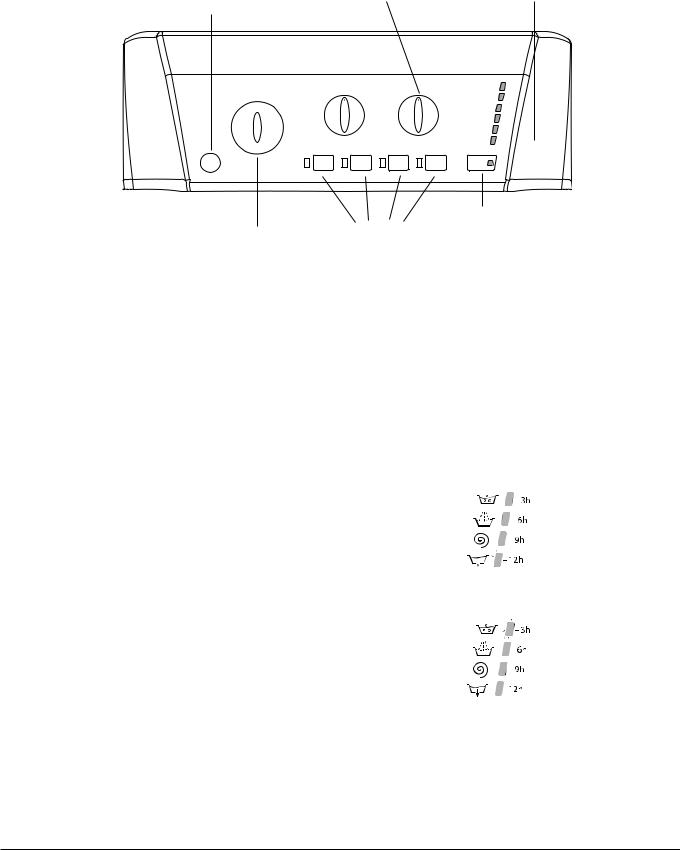
Description of the washing machine and starting a wash cycle
|
|
|
|
|
|
|
|
|
|
|
|
|
|
|
|
|
|
|
|
Control panel |
|
|
|
|
|
WASH CYCLE PROGRESS/ |
|||||||||
|
|
|
|
||||||||||||||
GB |
|
|
|
|
|
|
|
DELAY TIMER indicator lights |
|||||||||
|
|
|
|
|
SPIN SPEED |
|
|
|
|
|
|
|
|||||
|
|
|
|
|
|
|
|
|
|
||||||||
|
|
|
|
|
|
knob |
|
|
|
|
|
||||||
|
|
ON/OFF button |
TEMPERATURE |
|
|
|
|
|
|
|
|
|
|
|
LID LOCKED |
||
|
|
|
|
|
|
||||||||||||
|
|
|
|
|
|
|
|
|
|
|
|
|
indicator light |
||||
|
|
|
|
knob |
|
|
|
|
|
|
|
|
|
|
|
||
|
|
|
|
|
|
|
|
|
|
|
|
|
|
|
|
|
|
|
|
|
|
|
|
|
|
|
|
|
|
|
|
|
|
|
|
|
|
|
|
|
|
|
|
|
|
|
|
|
|
|
|
|
|
|
|
|
|
|
|
|
|
|
|
|
|
|
|
|
|
|
|
|
|
|
|
|
|
|
|
|
|
|
|
|
|
|
|
|
|
|
|
|
|
|
|
|
|
|
|
|
|
|
|
|
|
|
|
|
|
|
|
|
|
|
|
|
|
|
|
|
|
|
|
|
|
|
|
|
|
|
|
|
|
|
|
|
|
|
|
|
|
|
|
|
|
|
|
|
|
|
|
|
|
|
|
|
|
|
|
|
|
|
|
|
|
|
|
|
|
|
|
|
|
|
|
|
|
|
|
WASH CYCLE knob
ON/OFF button: switches the washing machine on and off.
WASH CYCLE knob: programmes the wash cycles. During the wash cycle, the knob does not move.
FUNCTION buttons with indicator light: used to select the available functions. The indicator light corresponding to the selected function will remain lit.
TEMPERATURE knob: sets the temperature or the cold wash cycle (see “Personalisation”).
SPIN SPEED knob: sets the spin speed or exclude the spin cycle completely (see “Personalisation”).
WASH CYCLE PROGRESS/DELAY TIMER indicator lights: used to monitor the progress of the wash cycle. The illuminated indicator light shows which phase is in progress.
If the Delay Timer function has been set, the time remaining until the wash cycle starts will be indicated
(see next page).
LID LOCKED indicator light: indicates whether the door may be opened or not (see next page).
START/PAUSE button with indicator light: starts or temporarily interrupts the wash cycles.
N.B. To pause the wash cycle in progress, press this button; the corresponding indicator light will flash orange, while the indicator light for the current wash cycle phase will remain lit in a fixed manner. If the LID LOCKED  indicator light is switched off, the door may be opened.
indicator light is switched off, the door may be opened.
START/PAUSE
button with indicator
FUNCTION light buttons with
indicator lights
To start the wash cycle from the point at which it was interrupted, press this button again.
Indicator lights
The indicator lights provide important information. This is what they can tell you:
Delayed start
If the DELAY TIMER function has been activated (see “Personalisation”), after the wash cycle has been started the indicator light corresponding to the selected delay period will begin to flash:
As time passes, the remaining delay will be displayed and the corresponding indicator light will flash:
Once the set delay has elapsed, the flashing indicator light will switch off and the selected wash cycle will begin.
Wash cycle phase indicator lights
Once the desired wash cycle has been selected and has begun, the indicator lights switch on one by one to indicate which phase of the cycle is currently in progress.
4
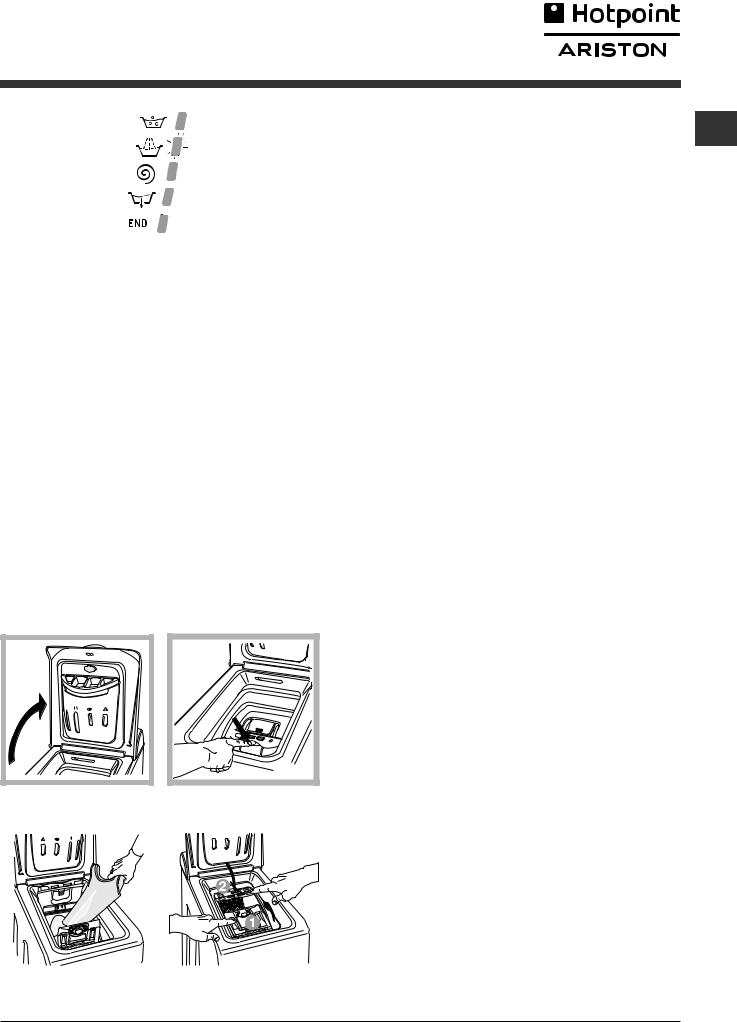
Wash
Rinse
Spin
Drain
End of wash cycle
Function buttons and corresponding indicator lights
When a function is selected, the corresponding indicator light will illuminate.
If the selected function is not compatible with the programmed wash cycle, the corresponding indicator light will flash and the function will not be activated. If a function which is incompatible with another function selected previously, only the most recent selection will remain active.
 Lid locked indicator light
Lid locked indicator light
If this indicator light is on, the appliance door is locked to prevent it from being opened accidentally; to avoid any damage, wait for the indicator light to switch off (it will take about three minutes) before you open the appliance door. N.B. If the DELAY TIMER function is activated, the door cannot be opened; pause the machine by pressing the START/PAUSE button if you wish to open it.
If the START/PAUSE indicator light (orange) flashes rapidly at the same time as the function indicator light, this indicates a problem has occurred (see “Troubleshooting”).
How to open and to close the drum
Fig. 1 |
|
Fig. 2 |
||||
|
|
|
|
|
|
|
|
|
|
|
|
|
|
|
|
|
|
|
|
|
Fig. 3 |
Fig. 4 |
A) Opening (Fig. 1):
Lift the external lid and open it completely. |
GB |
B)Opening the drum (Soft opening):
With one finger, push the button indicated in fig. 2 and the drum will open delicately.
C)Loading the washing machine (Fig. 3).
D)Shutting (Fig. 4):
-close the drum fully by first shutting the front door followed by the rear one;
-then ensure the hooks on the front door are perfectly housed within the seat of the rear door;
-after the hooks have clicked into position, press both doors lightly downwards to make sure they do not come loose;
-finally shut the external lid.
Starting a wash cycle
1.Switch the washing machine on by pressing the ON/OFF button. All indicator lights will switch on for a few seconds, then they will switch off and the START/ PAUSE indicator light will pulse.
2.Load the laundry, close the door and the lid.
3.Set the WASH CYCLE knob to the desired programme.
4.Set the washing temperature (see “Personalisation”).
5.Set the spin speed (see “Personalisation”).
6.Measure out the detergent and washing additives
(see “Detergents and laundry”).
7.Select the desired functions.
8.Start the wash cycle by pressing the START/ PAUSE button and the corresponding indicator light will remain lit in a fixed manner, in green.
To cancel the set wash cycle, pause the machine by pressing the START/PAUSE button and select a new cycle.
9.At the end of the wash cycle the 
 indicator light will switch on. The LID LOCKED indicator light will switch off, indicating that the door may be opened. Take out your laundry and leave the appliance door ajar to make sure the drum dries completely.
indicator light will switch on. The LID LOCKED indicator light will switch off, indicating that the door may be opened. Take out your laundry and leave the appliance door ajar to make sure the drum dries completely.
Switch the washing machine off by pressing the ON/ OFF button.
5

Wash cycles
Table of wash cycles
GB |
|
|
|
|
|
|
|
|
|
|
|
cycles |
|
Max. |
Max. |
Detergents |
Max. |
Cycle |
|||
|
|
|
||||||||
|
|
|
|
|
||||||
|
|
|
|
|
|
|
|
|||
|
|
Wash |
Description of the wash cycle |
temp. |
speed |
|
|
|
load |
duration |
|
|
|
|
Fabric |
||||||
|
|
|
(°C) |
(rpm) |
|
|
(kg) |
|||
|
|
|
Bleach |
Wash |
|
|||||
|
|
|
|
|
softener |
|
|
|||
|
|
|
|
|
|
|
|
|
|
|
|
|
|
Special cycles |
|
|
|
|
|
|
|
|
7 |
Sanitizing cycle 90°: Extremely soiled whites. |
90° |
800 |
l |
l |
l |
6 |
165 |
|
|
|
|
|
|
|
|
|
|
|
|
|
7 |
Sanitizing cycle 90° (1): Heavily soiled whites and resistant colours. |
60° |
800 |
- |
l |
l |
6 |
141 |
|
|
|
|
|
|
|
|
|
|
|
|
|
8 |
Goodnigt cycle: Lightly soiled delicate colours. |
40° |
800 |
- |
l |
l |
4 |
288 |
|
|
|
|
|
|
|
|
|
|
|
|
|
9 |
Baby cycle: Heavily soiled delicate colours. |
40° |
800 |
- |
l |
l |
2 |
116 |
|
|
|
|
|
|
|
|
|
|
|
|
|
10 |
Shirts |
40° |
600 |
- |
l |
l |
2 |
69 |
|
|
|
|
|
|
|
|
|
|
|
|
|
|
11 |
Silk/Curtains: For garments in silk and viscose, lingerie. |
30° |
0 |
- |
l |
l |
1 |
55 |
|
|
|
|
|
|
|
|
|
|
|
|
|
12 |
Wool: For wool, cashmere, etc. |
40° |
600 |
- |
l |
l |
1 |
55 |
|
|
|
|
|
|
|
|
|
|
|
|
|
|
Everyday wash cycles (Daily) |
|
|
|
|
|
|
|
|
1 |
Cotton + Prewash 90°: Extremely soiled whites. |
90° |
800 |
- |
l |
l |
6 |
164 |
|
|
|
|
|
|
|
|
|
|
|
|
|
2 |
Cotton: Heavily soiled whites and resistant colours. |
60° |
800 |
l |
l |
l |
6 |
138 |
|
|
|
|
|
|
|
|
|
|
|
|
|
2 |
Cotton (2): Heavily soiled whites and delicate colours. |
40° |
800 |
l |
l |
l |
6 |
123 |
|
|
|
|
|
|
|
|
|
|
|
|
|
3 |
Coloured Cottons (3): Lightly soiled whites and delicate colours. |
40° |
800 |
l |
l |
l |
6 |
89 |
|
|
|
|
|
|
|
|
|
|
|
|
|
4 |
Synthetics resistents: Heavily soiled resistant colours. |
60° |
800 |
- |
l |
l |
2,5 |
85 |
|
|
|
|
|
|
|
|
|
|
|
|
|
4 |
Synthetics delicates: Lightly soiled resistant colours. |
40° |
800 |
- |
l |
l |
2,5 |
73 |
|
|
|
|
|
|
|
|
|
|
|
|
|
|
5 |
Mix 30': To refresh lightly soiled garments quickly (not suitable for wool, |
30° |
800 |
- |
l |
l |
3 |
30 |
|
silk and clothes which require washing by hand). |
|||||||||
|
|
6 |
Mix 15': To refresh lightly soiled garments quickly (not suitable for wool, |
30° |
800 |
- |
l |
l |
1,5 |
15 |
|
silk and clothes which require washing by hand). |
|||||||||
|
|
|
Partials wash cycles |
|
|
|
|
|
|
|
|
|
|
Rinse |
- |
800 |
l |
- |
l |
6 |
36 |
|
|
|
|
|
|
|
|
|
|
|
|
|
|
Spin |
- |
800 |
- |
- |
- |
6 |
16 |
|
|
|
|
|
|
|
|
|
|
|
|
|
|
Light spin |
- |
800 |
- |
- |
- |
2,5 |
12 |
|
|
|
|
|
|
|
|
|
|
|
|
|
|
Drain no spin |
- |
0 |
- |
- |
- |
6 |
2 |
|
|
|
|
|
|
|
|
|
|
|
The information contained in the table is intended as a guide only.
For all Test Institutes:
1)Test wash cycle in compliance with regulation EN 60456: set wash cycle 7 with a temperature of 60°C.
2)Long wash cycle for cottons: set wash cycle 2 with a temperature of 40°C.
3)Short wash cycle for cottons: set wash cycle 3 with a temperature of 40°C.
Specials wash cycles
Sanitizing cycle (wash cycle 7). A high-temperature hygienic wash cycle (over 60°C) which requires the use of bleach. Pour the bleach, the detergent and the additives into the relevant compartments (see paragraph entitled
“Detergent dispenser drawer”).
Goodnigt cycle (wash cycle 8). This is a silent cycle which can be run at night, when the electricity prices are lower. The wash cycle is designed for cottons and synthetics. At the end of the cycle the machine stops while there is still water in the drum; to spin and drain the laundry press the START/PAUSE button; alternatively the machine will perform the spin cycle and drain the water automatically after 8 hours.
Baby cycle (wash cycle 9). This wash cycle can be used to remove the soiling typically caused by babies, while ensuring that all detergent is removed from nappies in order to prevent the delicate skin of babies from suffering allergies. The cycle has been designed to reduce the amount of bacteria by using a greater quantity of water and optimising the effect of special disinfecting additives added to the detergent.
Mix 30’ (wash cycle 5) this wash cycle was designed to wash lightly soiled garments quickly: it lasts just 30 minutes and therefore saves both energy and time. By selecting this wash cycle (5 at 30°C), it is possible to wash different fabrics together (except for wool and silk items), with a maximum load of 3 kg.
Mix 15’(wash cycle 6) this wash cycle was designed to wash lightly soiled garments quickly: it lasts just 15 minutes and therefore saves both energy and time. By selecting this wash cycle (6 at 30°C), it is possible to wash different fabrics together (except for wool and silk items), with a maximum load of 1.5 kg.
6

Personalisation
Setting the temperature
Turn the TEMPERATURE knob to set the wash temperature (see Table of wash cycles). |
GB |
|
|
The temperature may be lowered, or even set to a cold wash ( ). |
|
The washing machine will automatically prevent you from selecting a temperature which is higher than the |
|
maximum value set for each wash cycle. |
|
Setting the spin speed
Turn the SPIN SPEED knob to set the spin speed for the selected wash cycle.
The maximum spin speeds available for each wash cycle are as follows:
Wash cycles |
Maximum spin speed |
Cottons |
800 rpm |
Synthetics |
800 rpm |
Wool |
600 rpm |
Silk |
drain only |
The spin speed may be lowered, or the spin cycle can be excluded altogether by selecting the symbol  . The washing machine will automatically prevent you from selecting a spin speed which is higher than the maximum speed set for each wash cycle.
. The washing machine will automatically prevent you from selecting a spin speed which is higher than the maximum speed set for each wash cycle.
Functions
The various wash functions available with this washing machine will help to achieve the desired results, every time. To activate the functions:
1.Press the button corresponding to the desired function;
2.the function is enabled when the corresponding indicator light is illuminated.
Note: If the indicator light flashes rapidly, this signals that this particular function may not be selected in conjunction with the selected wash cycle.
 Super Wash
Super Wash
Because a greater quantity of water is used in the initial phase of the cycle, and because of the increased cycle duration, this function offers a high-performance wash.
This function may not be used in conjunction with wash cycles 5, 6, 7, 11, 12,  ,
,  ,
,  ,
,  .
.
 Extra rinse
Extra rinse
By selecting this function, the efficiency of the rinse is increased and optimal detergent removal is guaranteed. It is particularly useful for sensitive skin.
This function may not be used in conjunction with wash cycles 5, 6,  ,
,  ,
,  .
.
 Easy iron
Easy iron
By selecting this function, the wash and spin cycles will be modified in order to reduce the formation of creases. At the end of the cycle the washing machine will perform slow rotations of the drum.
For the 4, 8, 11 wash cycle, the machine will end the cycle while the laundry is soaking, the EASY IRON and START/PAUSE indicator lights will flash (orange) and the RINSE phase will remain lit in a fixed manner. To drain the water so that the laundry may be removed, press the START/PAUSE button or the EASY IRON button.
This function may not be used in conjunction with wash cycles 5, 6, 7, 8, 9, 12,  ,
,  ,
,  .
.
 Delay timer
Delay timer
This timer delays the start time of the wash cycle by up to 12 hours.
Press the button repeatedly until the indicator light corresponding to the desired delay time switches on. The fifth time the button is pressed, the function will be disabled.
N.B. Once you have pressed the START/PAUSE button, the delay time may only be decreased if you wish to modify it.
This option is enabled with all programmes.
7

Detergents and laundry
Detergent dispenser drawer
GB
Good washing results also depend on the correct dose of detergent: adding too much detergent won't necessarily make for a more efficient wash, and may in fact cause build up on the interior of your appliance and even pollute the environment.
Open up the detergent dispenser and pour in the detergent and fabric softener, as follows.
compartment 1: Detergent for pre-wash
compartment 2: Detergent for the wash cycle (powder or liquid)
It is recommended that you place liquid detergent directly into the compartment using the appropriate dosing cup.
compartment 3: Additives (softener, etc.)
When pouring the softener in compartment 3, avoid exceeding the "max" level indicated.
The softener is added automatically into the machine during the last wash. At the end of the wash programme, some water will be left in compartment 3. This is used for the inlet of denser fabric softeners into the machine, i.e. to dilute the more concentrated softeners. Should more than a normal amount of water remain in compartment 3, this means the emptying device is blocked. For cleaning instructions, see “Care and maintenance”.
compartment 4: Bleach
Preparing the laundry
•Divide the laundry according to:
-the type of fabric/the symbol on the label
-the colours: separate coloured garments from whites.
•Empty all garment pockets and check the buttons.
•Do not exceed the listed values, which refer to the weight of the laundry when dry:
Durable fabrics: max. 6 kg Synthetic fabrics: max. 2,5 kg Delicate fabrics: max. 2 kg Wool: max. 1 kg
How much does your laundry weigh?
1sheet 400-500 g
1pillow case 150-200 g
1tablecloth 400-500 g
1bathrobe 900-1200 g
1towel 150-250 g
Garments requiring special care
Shirts: use special wash cycle 10 to wash shirts in various fabrics and colours.
It guarantees maximum care is taken of the garments and minimises the formation of creases.
Silk: use special wash cycle 11 to wash all silk garments. We recommend the use of special detergent which has been designed to wash delicate clothes.
Curtains: fold curtains and place them in a pillow case or mesh bag. Use wash cycle 11.
Wool: Hotpoint/Ariston is the only washing machine manufacturer to have been awarded the prestigious Woolmark Platinum Care endorsement (M.0508) by the Woolmark Company, which means that all woollen garments may be washed in the washing machine, even those which state “hand wash only”
 on the label. Wash cycle 12 therefore offers complete peace of mind when washing woollen garments in the washing machine (max. load 1 kg) and guarantees optimal performance.
on the label. Wash cycle 12 therefore offers complete peace of mind when washing woollen garments in the washing machine (max. load 1 kg) and guarantees optimal performance.
Bleach cycle
Bleaching may only be performed in conjunction with wash cycles 2, 3, 7,  .
.
Pour the bleach into compartment 4; pour the detergent and softener into the corresponding compartments, then select one of the abovementioned wash cycles.
This option is recommended only for very soiled cotton garments.
Load balancing system
Before every spin cycle, to avoid excessive vibrations and to distribute the load in a uniform manner, the drum rotates continuously at a speed which is slightly greater than the washing rotation speed. If, after several attempts, the load is not balanced correctly, the machine spins at a reduced spin speed. If the load is excessively unbalanced, the washing machine performs the distribution process instead of spinning. To encourage improved load distribution and balance, we recommend small and large garments are mixed in the load.
8

Precautions and tips
This washing machine was designed and constructed in accordance with international safety regulations. The following information is provided for safety reasons and must therefore be read carefully.
General safety
•This appliance was designed for domestic use only.
•The washing machine must only be used by adults, in accordance with the instructions provided in this manual.
•Do not touch the machine when barefoot or with wet or damp hands or feet.
•Do not pull on the power supply cable when unplugging the appliance from the electricity socket. Hold the plug and pull.
•Do not touch the drained water as it may reach extremely high temperatures.
•Never force the porthole door. This could damage the safety lock mechanism designed to prevent accidental opening.
•If the appliance breaks down, do not under any circumstances access the internal mechanisms in an attempt to repair it yourself.
•Always keep children well away from the appliance while it is operating.
•If the appliance has to be moved, work in a group of two or three people and handle it with the utmost care. Never try to do this alone, because the appliance is very heavy.
•Before loading laundry into the washing machine, make sure the drum is empty.
Disposal
•Disposing of the packaging materials: observe local regulations so that the packaging may be re-used.
•The European Directive 2002/96/EC on Waste Electrical and Electronic Equipment, requires that old household electrical appliances must not be disposed of in the normal unsorted municipal waste stream. Old appliances must be collected separately in order to optimise the recovery and recycling of the materials they contain and reduce the impact on human health and the environment. The crossed out "wheeled bin" symbol on the product reminds you of your obligation, that when you dispose of the appliance it must be separately collected.
Consumers should contact their local authority or retailer for information concerning the correct disposal of their old appliance.
Saving energy and respecting the |
GB |
environment |
Saving on detergent, water, energy and time
•To avoid wasting resources, the washing machine should be used with a full load. A full load instead of two half loads allows you to save up to 50% on energy.
•The pre-wash cycle is only necessary on extremely soiled garments. Avoiding it will save on detergent, time, water and between 5 and 15% energy.
•Treating stains with a stain remover or leaving them to soak before washing will cut down the need to wash them at high temperatures. A programme at 60°C instead of 90°C or one at 40°C instead of 60°C will save up to 50% on energy.
•Use the correct quantity of detergent depending on the water hardness, how soiled the garments are and the amount of laundry you have, to avoid wastage and to protect the environment: despite being biodegradable, detergents do contain ingredients that alter the natural balance of the environment. In addition, avoid using fabric softener as much as possible.
•If you use your washing machine from late in the afternoon until the early hours of the morning, you will help reduce the electricity board's peak load. The “Delay Timer” option helps to organise your wash cycles accordingly.
•If your laundry has to be dried in a tumble dryer, select a high spin speed. Having the least water possible in your laundry will save you time and energy in the drying process.
9

Care and maintenance
Cutting off the water or electricity GB supply
•Turn off the water tap after every wash. This will limit the wear of your appliance's water system and also prevent leaks.
•Unplug your appliance when cleaning it and during all maintenance operations.
Cleaning your appliance
The exterior and rubber parts of your appliance can be cleaned with a soft cloth soaked in lukewarm soapy water. Do not use solvents or abrasives.
Caring for your appliance door and drum
•Always leave the appliance door ajar to prevent unpleasant odours from forming.
Cleaning the pump
The washing machine is fitted with a self-cleaning pump that does not require any maintenance. Sometimes, small items (such as coins or buttons) may fall into the pre-chamber that protects the pump, situated in the lower part of the same.
Make sure the wash cycle has ended and unplug the appliance.
To recover any objects that have fallen into the prechamber:
1. remove the plinth at the bottom on the front side of the washing machine by pulling from the side with your hands (see figure);
2. unscrew the lid rotating it anticlockwise (see figure): a little water may trickle out. This is perfectly normal; 3. clean the interior thoroughly;
4. screw the lid back on;
5. reposition the panel, making sure the hooks are securely in place before you push it onto the appliance.
Checking the water inlet hose
Check the water inlet hose at least once a year. If you see any cracks, replace it immediately: during the wash cycles, water pressure is very strong and a cracked hose could easily split open.
Never use hoses that have already been used.
Disassembly:
Press lightly on the large button on the front of the detergent dispenser and pull it upwards (fig. 1, 2).
How to clean the detergent dispenser
Cleaning:
Then clean the dispenser under a tap (fig. 3) using an old toothbrush and, once the pair of siphons inserted in the top of compartments 1 and 2 (fig. 4) have been pulled out, check whether the same are not clogged and then rinse them.
Reassembly:
Do not forget to reinsert the pair of siphons into the special housings and then to replace the dispenser into its seat, clicking it into place
(fig. 4, 2 and 1).
Fig. 1 |
Fig. 2 |
Fig. 3 |
Fig. 4 |
|
|
|
|
10

Troubleshooting
Your washing machine could fail to work. Before contacting the Technical Assistance Centre (see “Assistance”),
make sure that the problem cannot be not solved easily using the following list. |
GB |
|
|
||
Problem: |
Possible causes / Solutions: |
|
The washing machine does not switch on.
The wash cycle does not start.
•The appliance is not plugged into the socket fully, or is not making contact.
•There is no power in the house.
•The appliance Lid is not shut properly.
•The ON/OFF button has not been pressed.
•The START/PAUSE button has not been pressed.
•The water tap has not been opened.
•A delayed start has been set (see “Personalisation”).
The washing machine does not take in water (the indicator light for the first wash cycle stage flashes rapidly).
•The water inlet hose is not connected to the tap.
•The hose is bent.
•The water tap has not been opened.
•There is no water supply in the house.
•The pressure is too low.
•The START/PAUSE button has not been pressed.
The washing machine continuously takes in and drains water.
•The drain hose is not fitted at a height between 65 and 100 cm from the floor (see “Installation”).
•The free end of the hose is under water (see “Installation”).
•The wall drainage system is not fitted with a breather pipe.
If the problem persists even after these checks, turn off the water tap, switch the appliance off and contact the Assistance Service. If the dwelling is on one of the upper floors of a building, there may be problems relating to water drainage, causing the washing machine to fill with water and drain continuously. Special anti-draining valves are available in shops and help to avoid this inconvenience.
The washing machine does not drain or spin.
•The wash cycle does not include draining: some wash cycles require the drain phase to be started manually.
•The EASY IRON function has been activated: To complete the wash cycle, press the START/PAUSE button (“Personalisation”).
•The drain hose is bent (see “Installation”).
•The drainage duct is clogged.
The washing machine vibrates a • The drum was not unlocked correctly during installation (see “Installation”). lot during the spin cycle. • The washing machine is not level (see “Installation”).
• The washing machine is trapped between cabinets and walls (see “Installation”).
The washing machine leaks. • The water inlet hose is not screwed on properly (see “Installation”).
•The detergent dispenser drawer is blocked (for cleaning instructions, see “Care and maintenance”).
•The drain hose is not fixed properly (see “Installation”).
The START/PAUSE indicator light (orange) and the function indicator lights flash rapidly.
There is too much foam.
•Switch off the machine and unplug it, wait for approximately 1 minute and then switch it back on again.
If the problem persists, contact the Technical Assistance Service.
•The detergent is not suitable for machine washing (it should display the text “for washing machines” or “hand and machine wash”, or the like).
•Too much detergent was used.
11

Service
Before calling for Assistance:
GB |
• Check whether you can solve the problem alone (see “Troubleshooting”); |
|
|
|
• Restart the programme to check whether the problem has been solved; |
|
• If this is not the case, contact an authorised Technical Assistance Centre using the telephone number |
|
provided on the guarantee certificate. |
|
Always request the assistance of authorised technicians. |
Have the following information to hand:
•the type of problem;
•the appliance model (Mod.);
•the serial number (S/N).
This information can be found on the data plate situated on the rear of the washing machine.
12

Mode d’emploi
LAVE-LINGE
|
|
|
|
|
|
|
|
Sommaire |
|
||
|
|
FR |
|||
|
|
|
|
||
|
|
Installation, 14-15 |
|
||
FR |
|
|
|||
|
Déballage et mise à niveau |
||||
|
|
Raccordements eau et électricité |
|||
Français |
|||||
Premier cycle de lavage |
|||||
|
|
Caractéristiques techniques |
|||
ARTXL 89
Description du lave-linge et démarrage d’un programme, 16-17
Bandeau de commandes Voyants
Comment ouvrir et fermer le tambour Démarrage d’un programme
Programmes,18
Tableau des programmes
Personnalisations, 19
Sélection de la température
Sélection de l’essorage
Fonctions
Produits lessiviels et linge, 20
Tiroir à produits lessiviels Cycle blanchissage Triage du linge
Linge ou vêtements particuliers Système d’équilibrage de la charge
Précautions et conseils, 21
Sécurité générale Mise au rebut
Economies et respect de l'environnement
Entretien et soin, 22
Coupure de l’arrivée d’eau et du courant Nettoyage du lave-linge
Entretien du couvercle et du tambour Nettoyage de la pompe
Contrôle du tuyau d’arrivée de l’eau Comment nettoyer le tiroir à produits lessiviels
Anomalies et remèdes, 23
Assistance, 24
13
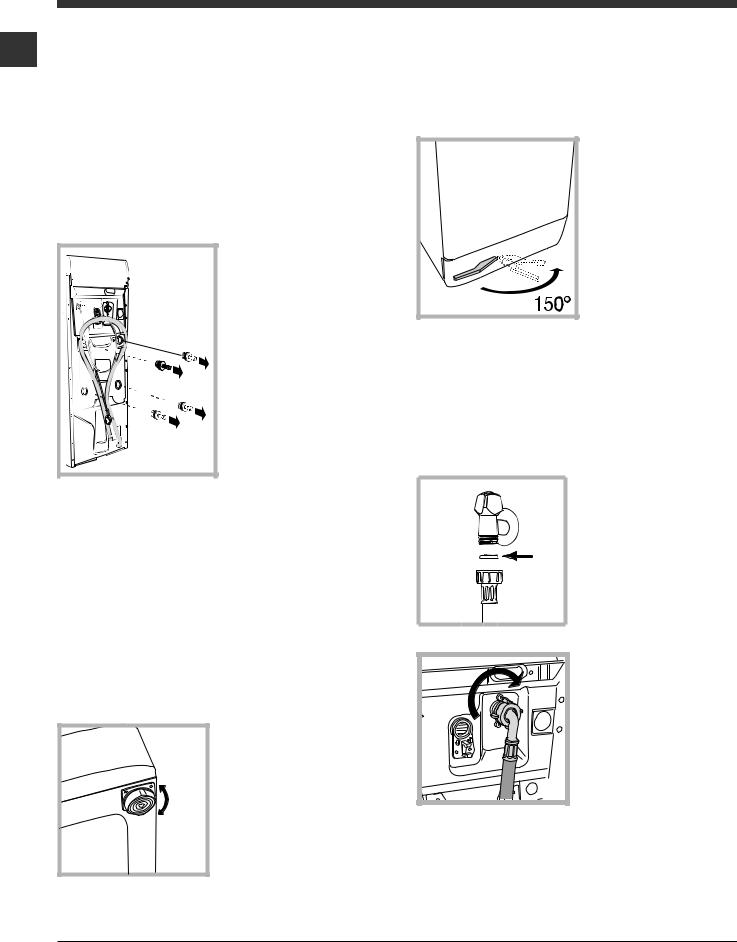
Installation
Conservez ce mode d'emploi pour pouvoir le
FR consulter à tout moment. En cas de vente, de cession ou de déménagement, veillez à ce qu'il suive toujours le lave-linge pour que son nouveau propriétaire soit informé sur son mode de fonctionnement et puisse profiter des conseils correspondants.
Lisez attentivement les instructions: elles fournissent d'importantes informations sur l'installation, l'utilisation et la sécurité.
Déballage et mise à niveau
Déballage: enlever les 4 vis
1. Déballez le lave-linge.
2. Contrôlez que le lave-linge n'a pas été endommagé pendant le transport. S'il est abîmé, ne le raccordez pas et contactez votre revendeur.
3. Enlevez les quatre vis de protection pour le transport, le caoutchouc et la cale, placés dans la partie arrière (voir figure).
4.Bouchez les trous à l'aide des bouchons plastique fournis.
5.Conservez bien toutes ces pièces: il faudra les remonter en cas de transport du lave-linge.
Attention: en cas de réutilisation, les vis plus courtes doivent être montées dessus.
Les emballages ne sont pas des jouets pour enfants.
Mise à niveau
Votre appareil peut s’avérer bruyant si vous n’avez pas bien réglé ses deux pieds avant.
1.Installez le lave-linge sur un sol plat et rigide, sans l'appuyer contre des murs, des meubles ou autre.
2. Si le sol n'est pas parfaitement horizontal, vissez ou dévissez les petits pieds avant (voir figure) pour niveler l'appareil; son angle d'inclinaison, mesuré sur le plan de travail, ne doit pas dépasser 2°.
Une bonne mise à niveau garantit la stabilité de la machine et évite qu'il y ait des vibrations, du bruit et des déplacements en cours de fonctionnement. Si la
machine est posée sur de la moquette ou un tapis, réglez les petits pieds de manière à ce qu'il y ait suffisamment d'espace pour assurer une bonne ventilation.
Mise en place, deplacements
Si votre lave-linge est muni d'un chariot spécial avec roues rétractiles, vous pouvez le déplacer facile-ment. Pour faire descendre ce chariot et pouvoir ainsi déplacer
sans effort votre lave-
linge, vous devez tirer le
levier situé en bas à
gauche, sous la base. Une fois le lave-linge déplacé, remettez-le
dans la position initiale. Le lave-linge est ainsi solidement mis en place. Voir figure (seulement pour les modéles
prevues).
Raccordements hydrauliques et électriques
Raccordement du tuyau d'arrivée de l'eau
1. Montez le joint A sur l'extrémité du tuyau d'alimentation et vissez-le à un robinet d'eau froide à embout fileté 3/4 gaz
A |
(voir figure). |
|
|
|
Faites couler l'eau |
|
jusqu'à ce qu'elle soit |
|
limpide et sans impuretés |
|
avant de raccorder. |
|
2. Raccordez le tuyau |
|
d'alimentation au lave- |
|
linge en le vissant à la |
|
prise d'eau prévue, dans |
|
la partie arrière en haut à |
|
droite (voir figure). |
|
3. Faites attention à ce |
|
que le tuyau ne soit ni |
|
plié ni écrasé. |
La pression de l'eau doit être comprise entre les valeurs indiquées dans le tableau des Caractéristiques techniques (voir page ci-contre).
Si la longueur du tuyau d'alimentation ne suffit pas, adressez-vous à un magasin spécialisé ou à un technicien agréé.
14
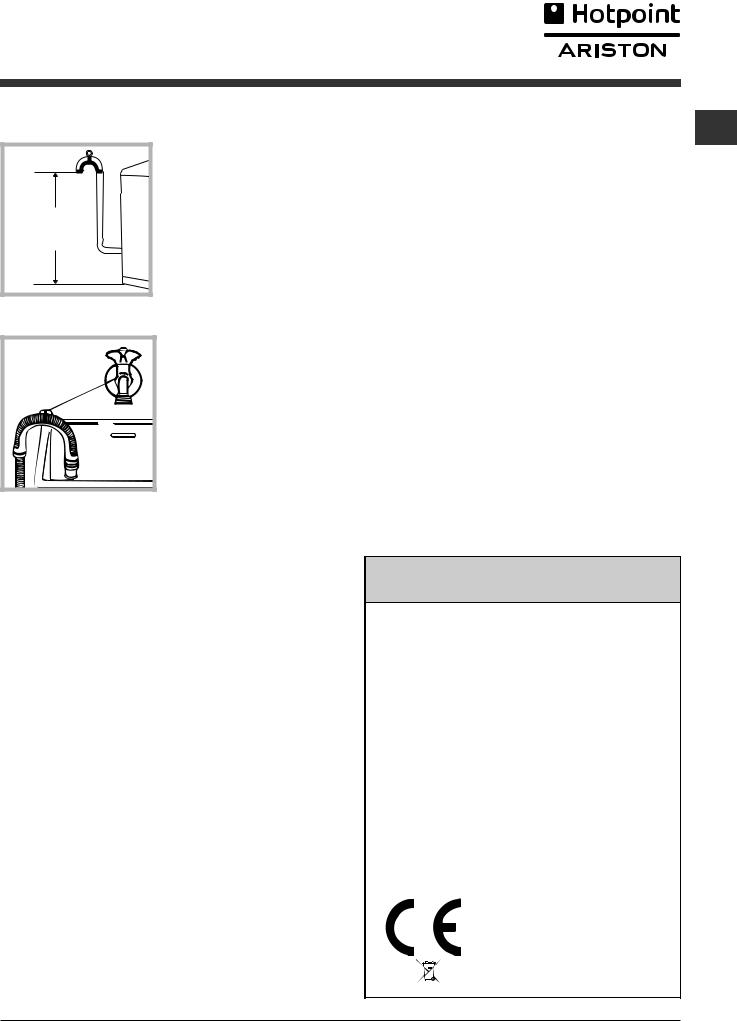
Raccordement du tuyau de vidange
65 - 100 cm |
Raccorder le tuyau d’évacuation, sans le plier, à un conduit d’évacuation ou à une évacuation murale placés à une distance du sol comprise entre 65 et 100 cm;
ou bien l’accrocher à un évier ou à une baignoire, dans ce cas, fixer le support en plastique fourni avec l’appareil au robinet (voir figure). L’extrémité libre du tuyau d’évacuation ne doit pas être plongée dans l’eau.
L’utilisation d’un tuyau de rallonge est absolument déconseillée mais si on ne peut faire autrement, il faut absolument qu’il ait le même diamètre que le tuyau original et sa longueur ne doit pas dépasser 150 cm.
Branchement électrique
Avant de brancher la fiche dans la prise de courant, s’assurer que:
•la prise est bien reliée à la terre et est conforme aux réglementations en vigueur;
•la prise est bien apte à supporter la puissance maximale de l’appareil indiquée dans le tableau des Caractéristiques techniques (voir ci-contre);
•la tension d’alimentation est bien comprise entre les valeurs figurant dans le tableau des Caractéristiques techniques (voir ci-contre);
•la prise est bien compatible avec la fiche du lavelinge. Autrement, remplacer la prise ou la fiche.
Le lave-linge ne doit pas être installé dehors, même à l’abri, car il est très dangereux de le laisser exposé à la pluie et aux orages.
Après installation du lave-linge, la prise de courant doit être facilement accessible.
N’utiliser ni rallonges ni prises multiples.
FR
Le câble ne doit être ni plié ni trop écrasé.
Le câble d’alimentation ne doit être remplacé que par des techniciens agréés.
Attention! Nous déclinons toute responsabilité en cas de non-respect des normes énumérées ci-dessus.
Premier cycle de lavage
Avant la première mise en service de l’appareil, effectuer un cycle de lavage avec un produit lessiviel mais sans linge et sélectionner le programme 2.
Caractéristiques techniques
Modèle |
ARTXL 89 |
|||
|
|
|
|
|
|
|
|
largeur 40 cm |
|
Dimensions |
hauteur 85 cm |
|||
|
|
|
profondeur 60 cm |
|
|
|
|||
Capacité |
de 1 à 6 kg |
|||
|
|
|||
Raccordements |
Voir la plaque signalétique appliquée |
|||
électriques |
sur la machine |
|||
|
|
|
|
|
Raccordements |
pression maximale 1 MPa (10 bar) |
|||
pression minimale 0,05 MPa (0,5 bar) |
||||
hydrauliques |
||||
capacité du tambour 42 litres |
||||
|
|
|
||
|
|
|||
Vitesse |
jusqu'à 800 tours minute |
|||
d'essorage |
||||
|
||||
|
|
|||
Programmes de |
programme 7; température 60°C; |
|||
contrôle selon la |
||||
effectué avec une charge de 6 kg. |
||||
norme EN 60456 |
||||
|
||||
|
|
|
|
|
|
|
|
Cet appareil est conforme aux |
|
|
|
|
Directives Communautaires suivantes: |
|
|
|
|
- 89/336/CEE du 03/05/89 |
|
|
|
|
(Compatibilité électromagnétique) et |
|
|
|
|
modifications suivantes |
|
|
|
|
- 2002/96/CE |
|
|
|
|
- 2006/95/CE (Basse Tension) |
|
|
|
|
||
15
